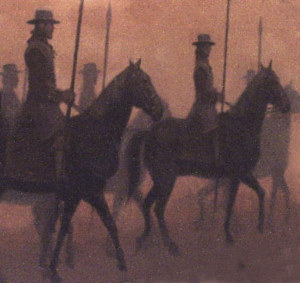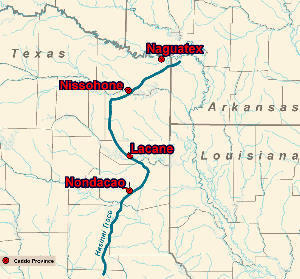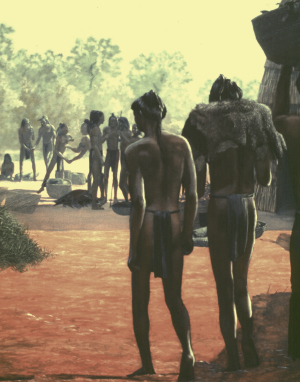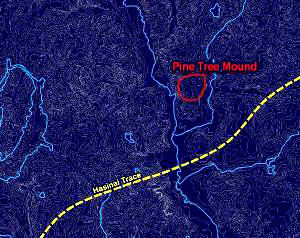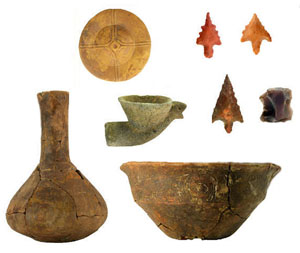West view of the large temple mound at the Pine Tree Mound site. Inset painting of Caddo chinesi by Reeda Peel. |
In the summer of 1542, the several hundred people making up the Hernando De Soto expedition entered what is today the northeast corner of Texas after travelling more than three years across the southeastern U.S. De Soto had died a few months earlier, and Luis de Moscoso Alvarado was their new leader. Here, they met the first of several groups of Caddo and other Indians they would encounter before leaving Texas on their way back to the Mississippi River. They called this first Caddo group, who lived on the Red River near present-day Texarkana, Naguatex. After a few days, they left the Red River and traveled south, probably on an ancient Indian trail known as the Hasinai Trace. One of the few written accounts of this expedition reports that: ...after marching three days [they] reached a town of four or five houses, belonging to the cacique of that miserable province, called Nissohone. It was a poorly populated region and had little maize. Two days later, the guides who were guiding the governor [de Moscoso Alvarado], if they had to go toward the west, guided them toward the east, and sometimes they went through dense forests, wandering off the road. The governor ordered them hanged from a tree, and an Indian woman, who had been captured at Nissohone, guided him, and he went back to look for the road. Two days later, he [de Moscoso Alvarado] reached another wretched land called Lacane. There he captured an Indian who said that the land of Nondacao was a very populous region and the houses are scattered about one from another as is customary in mountains, and that there was an abundance of maize. The cacique [of Nondacao] and his Indians came weeping like those of Naguatex, that being their custom in token of obedience. He made him [de Moscoso Alvarado, the governor] a gift of a great quantity of fish and offered to do as he should order. He took his leave of him and gave him a guide to the province of Soacatino. Archeologists and historians have long thought that this group of Nondacao Caddo Indians lived somewhere in the Piney Woods along the middle Sabine River, near the cities of Longview and Marshall. The fact that a historic trail known as Trammel’s Trace ran through this area, following the old Hasinai Trace, is one reason for this. Another is that Pedro Vial, a French pathfinder, passed through the middle Sabine basin in 1788 when travelling from Santa Fe, New Mexico, to Natchitoches, Louisiana, and recorded a group called the Nadaco as living there in a village of 13–15 houses scattered over a distance of 3 leagues, or about 9 miles. Because Nondacao and Nadaco are historic variants of the same Caddo word, Nadaakuh, (meaning “the place of the bumblebee” or the people of that place), there is every reason to think that the people Pedro Vial met were the descendants of those who gave Luis de Moscoso Alvarado a feast of fish 246 years earlier. A Community RevealedThe latest chapter in this story unfolded between 2004 and 2012, when excavations at an archeological site called Pine Tree Mound (41HS15) recovered evidence that it was the political and social heart of the Caddo province of Nadaco, starting in the 1300s and continuing perhaps as late as the 1700s. This site, in what is today south-central Harrison County, is large, covering an area of about 36 acres on a finger of upland north of where Potters Creek flows onto the wide Sabine River floodplain. The archeological investigation, conducted by Prewitt and Associates, Inc., of Austin, was necessary because the site was in the path of a lignite mine. As a result of this work, the mine modified their plan in order to avoid the core ceremonial area of the site, which the project sponsor then purchased for preservation. Although the residential areas adjacent to the ceremonial complex could not be avoided by the mine, investigations in those areas provided important insights about community structure and daily life. Archeological investigations revealed that Pine Tree Mound was the site of more than a dozen residential household compounds ringing a ceremonial precinct with three temple mounds. There priests and leaders, including the cacique, performed the rituals that cemented the community together. Archeologists know of no other site of the same age in this region that has such a well-defined ceremonial landscape, and it is clear that this was home to a powerful ruler. With the Hasinai Trace passing near the Pine Tree Mound community and crossing Potters Creek just south of it, it is inconceivable that this ruler and his people were unaware of the several hundred Spaniards and Portuguese as they passed by in July 1542. We do not know if this encounter, brief as it was, relates in any way to changes evident at the Pine Tree Mound site starting in the latter half of the 1500s. It is easy to imagine that it did, though, with that contact resulting in population loss from introduced infectious diseases. The information archeologists retrieved at Pine Tree Mound is exciting for what it tells us about the prehistory and history of this part of northeast Texas. But the benefits exceed those of many archeological projects in two ways. One is that this is a history of a people we can connect to a living group of Native Americans, the Anadarko Caddo, who make up part of the Caddo Nation of Oklahoma today. The other is that, through the generosity of the project sponsors, the heart of this site is now owned by the Archaeological Conservancy, an organization dedicated to preserving some of the country’s most important sites.
|
|
